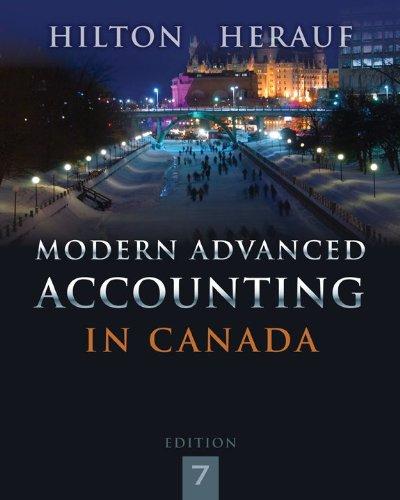The balance sheets of Forest Company and Garden Company are presented below as at December 31, Year
Question:
-1.png)
Additional Information
€¢ Forest acquired 90% of Garden for $207,900 on July 1, Year 1, and accounts for its investment under the cost method. At that time, the shareholders€™ equity of Garden amounted to $175,000, the accumulated amortization was $95,000, and the assets of Garden were undervalued by the following amounts:
Inventory......... $12,000
Buildings......... $10,000 remaining life, 10 years
Patents ......... $16,000 remaining life, 8 years
€¢ During Year 8, Forest reported net income of $41,000 and declared dividends of $25,000, whereas Garden reported net income of $63,000 and declared dividends of $50,000.
€¢ During Years 2 to 7, goodwill impairment losses totalled $1,950. An impairment test conducted in Year 8 indicated a further loss of $7,150.
€¢ Forest sells goods to Garden on a regular basis at a gross profit of 30%. During Year 8, these sales totalled $150,000. On January 1, Year 8, the inventory of Garden contained goods purchased from Forest amounting to $18,000, while the December 31, Year 8, inventory contained goods purchased from Forest amounting to $22,000.
€¢ On August 1, Year 6, Garden sold land to Forest at a profit of $18,000. During Year 8, Forest sold one-quarter of the land to an unrelated company.
€¢ Forest€™s bonds have a par value of $100,000, pay interest annually on
December 31 at a stated rate of 6%, and mature on December 31, Year 11. Forest incurs an effective interest cost of 8% on these bonds. They had a carrying amount of $93,376 on January 1, Year 8. On that date, Garden acquired $60,000 of these bonds on the open market at a cost of $57,968. Garden will earn an effective rate of return of 7% on them. Both companies use the effective-interest method to account for their bonds.
The Year 8 income statements of the two companies show the following with respect to bond interest.
-2.png)
€¢ Garden owes Forest $22,000 on open account on December 31, Year 8.
€¢ Assume a 40% corporate tax rate and allocate bond gains (losses) between the two companies.
Required:
(a) Prepare the following statements:
(i) Consolidated balance sheet
(ii) Consolidated retained earnings statement
(b) Prepare the Year 8 journal entries that would be made on the books of Forest if the equity method was used to account for the investment.
(c) Explain how a loss on the elimination of intercompany bondholdings is viewed as a temporary difference and gives rise to a deferred income tax asset.
(d) If Forest had used parent company extension theory rather than entity theory, how would this affect the debt-to-equity ratio at the end of Year 9?
Goodwill is an important concept and terminology in accounting which means good reputation. The word goodwill is used at various places in accounting but it is recognized only at the time of a business combination. There are generally two types of... Par Value
Par value is the face value of a bond. Par value is important for a bond or fixed-income instrument because it determines its maturity value as well as the dollar value of coupon payments. The market price of a bond may be above or below par,...
Step by Step Answer:

Modern Advanced Accounting In Canada
ISBN: 9781259066481
7th Edition
Authors: Hilton Murray, Herauf Darrell





